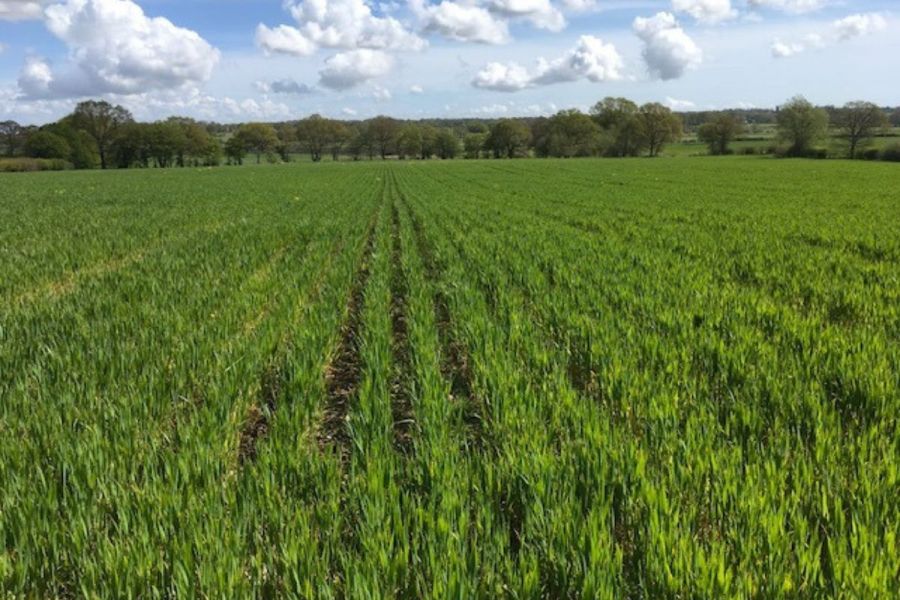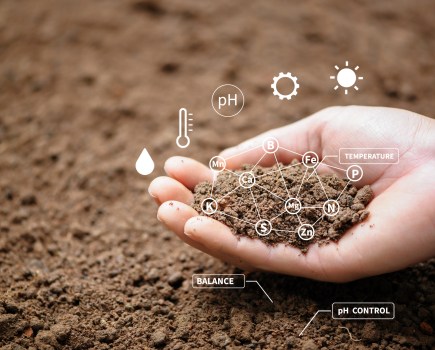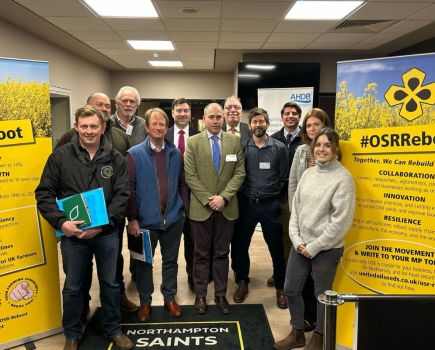Optimising establishment with a biological seed treatment is helping a golfer-turned-farmer stay competitive with his organic arable crops. CPM finds out more.
“I’m a strong believer that nature works so much with us until we work against it.”
By Charlotte Cunningham
What do professional golf and agriculture have in common? Truthfully, not a lot. However, that didn’t stop Paul Dobson trading in one career for the other in a bid to achieve his life-long dream of being an organic arable farmer.
Today, retired professional golfer Paul manages the arable enterprise of the 243ha Oxney Organic Estate in East Sussex, while his partner, Kristin Syltevik, is responsible for the 14ha vineyard – one of the largest organic vineyards in the UK – and several holiday cottages.
“We took the estate on in 2009 and converted it to organic in 2012, certifying with the Soil Association and Countryside Stewardship Scheme,” explains Paul. “For us, the organic aspect has been a lifestyle choice – if we were to become farmers, we had to be organic. That meant minimising the use of fossil fuels, using zero pesticides and focusing on natural methods. These are all at the centre of our farming practices.
“I’m a strong believer that nature works so much with us until we work against it. You just have to see that with climate change and how Mother Nature is fighting back.
I quickly learnt that once you let nature do its thing, plants become alive with wild insect predation. You don’t have to use chemicals, there are other ways.”
Today, the arable enterprise has grown with a typical rotation comprising two years of red clover ley for nitrogen fixing, followed by wheat, spring beans, winter wheat, spring oats and then back to clover. “We’re also trying to put a cover crop between the winter and spring crops to both build organic matter in the soil and hold on to any nitrogen left over from the winter crop, that we can then utilise in the spring crop,” explains Paul.
As well as the cropping, the farm is alive with beneficial insects, hares, deer and birds, he adds. “So much so, that in a recent bird survey of the vineyards, we were delighted to discover we have some of the highest variety and number of birds of all vineyards in the UK. Such high levels of biodiversity we find in our arable system too.”
But like many organic systems, while biodiversity may be thriving, so too are the weeds, and this is where managing the weed seed bank and establishing a competitive crop that’s quick to get away is crucial, explains Paul.
“A lot of our problem weeds – thistles, docks and grasses – emerge after crop establishment and can have a huge impact on yield. Finding ways to get the crops and fertility leys up and away ahead of weed competition, and manage those weeds in-season, is imperative.”
To do that, as well as focusing on soil health, Paul has been using a combination of crop rotation, cover crops, inter-row hoeing, and finding ways to feed and stimulate the crop not the weeds.
In terms of machinery, he’s inspired by John Pawsey and had been using the System Cameleon to drill his crops, before recently swapping to the Claydon Opti-Till. “We’re trying to retain weed seed in the top 5cm of the soil so we can kill it and deplete the seed bank. We leave the stubble after harvest and then create a false seedbed using the Claydon straw harrow. It creates a micro-tilth in the top 30mm of the soil that leads to fast, even weed germination and then we use it to rake out and destroy the weeds at the cotyledon to one leaf stage.
“In the past we’d be drilling around 20 October to give us a good window for stale seedbeds but with the wetter autumns we’re getting these days, we’d require a boat,” laughs Paul. “I aim to drill around 10 October before the weather turns. If I leave it any later I’d never get the crop in the ground.”
The typical plan is to establish the crop as soon as possible and then go in with the Claydon interrow hoe around March when most problem weeds have emerged. These are removed while they’re still small, before they swamp out the crop.
Just before drilling, Paul uses composted turkey manure to help feed the young seedlings and aid their establishment. “It was pointed out to me that in growing our crops, everything goes back into the soil except the seed, which is an important source of nitrogen and trace elements that we are taking away. So as well as using fertility building leys under NUM3, we also utilise nearby turkey litter. Being organic, we have to leave it six months to compost.”
Faced with increasing challenges to his crop establishment, Paul has also been utilising the benefits of Interagro’s organic biostimulant seed treatment Newton, to help crops get up and away early and produce fitter, healthier more competitive plants.
Newton is a natural, 100% organic plant-sourced biostimulant seed treatment, comprising stimulating peptides to help crops thrive from day one, explains Stuart Sutherland, technical manager at Interagro. “Not only do these peptides ensure vigorous crop establishment, they also help to build stronger, healthier, more resilient plants that will thrive under stress, delivering higher yield and margin gains.”
Paul continues: “I always have my home-saved seed cleaned by Anglia Grain Services, but obviously in an organic system you can’t put any chemical dressings on, so selecting and planting the fittest seed puts us in good stead.
“They use a gravity table which separates out really small seed from the big seed as it cleans. The small seed is put back on the seed stack in the grain store and we bag up the bolder grain for drilling.”
It was also through Anglia Grain Services that Paul first heard about Newton, who’d recommended it to help optimise emergence and establishment. “It sounded good, so of the 23t of KWS Zyatt wheat I had cleaned, half was dressed with Newton.”
Combining optimal seed size with Newton offers the best start to growers – particularly under challenging conditions – believes Matt Pickard, business development manager at Anglia Grain Services. “With the wetter winters and drier springs, helping crops to get up and away fast and put their roots down is becoming increasingly vital.
“Wetter autumns seem to be the norm which can lead to lazy roots. The roots won’t travel far to find water which can cause problems such as lodging, unused nutrients deeper in the seedbed, and if conditions change, there’s a risk of drought and stunted growth.
“Seed quality is important to get the crop away – if you start with bad seed or a bad start, you’ll always be trying to catch up and that’s not a good position to be in.”
In independent trials, larger seed has been proven to provide better rooting and vigour in plants compared with smaller seed, he continues. “This is because bigger seed contains more energy and nutrients which are essential for the growth and development of the plant.
“Adding Newton to the seed means as well as providing big, bold, superior seed we can benefit emergence and rooting even further, which is what I recommended to Paul.”
Looking ahead to autumn, Matt points out that growers could also benefit from quality farm saved seed. “Reduced autumn 2023 sowings and quality challenges in certified seed seed crops due to the wet autumn, means an anticipated shortfall in certified autumn cereal seed,” he says. “Keeping farm saved seed this autumn is a good way to put you in control of your seed requirements this autumn, while maintaining high quality standards.
“We always advise testing for germination and disease when farm saving seed as there are many seed and soil-borne fungal diseases which can severely impact yield and quality. Where necessary, we’d always recommend using an appropriate chemical dressing to protect the seed.
“If growers can’t or choose not to use a chemical dressing, at least with Newton it gives crops the best start to establishment. If we do end up with a wet autumn and you can’t get on to give crops nutrition, you’ve done your best to help crops put their roots down and access what’s naturally available.”
Turning focus back to Paul’s Newton-treated seed, areas were planted as first wheat after a red clover ley, drilled into good moist seedbeds in ideal weed-free conditions. “The Indian summer we had that year quickly turned extremely wet and while parts of the field should have drowned – there’s one block that often sits wet and we don’t get much of a crop – where seed was dressed with Newton it grew away nice and strong to my surprise.”
Into winter, the block treated with Newton looked really well compared with untreated seed despite the horrendous autumn, notes Paul. “With Newton, we saw vigorous early growth and strong plants instead of thin, leggy plants.
“I didn’t pull plants, but knowing what I know now about Newton, I think the improved rooting must have played a part in improving the crop’s resilience and providing the means to a daily feed of deliciousness without having to do any work.”
Improving the ability of plants to root is not only crucial for nutrient uptake, but also improving soil structure and helping to build that crucial organic matter in the soil, he adds. “This is all part of keeping our soils in good health and where Newton fits in well. Our soil organic matter levels range from 4.5 to 8 which I think is pretty good. Once you can rely on nature, it’s amazing what it will give you.”
So what’s next for Paul? “This autumn, all of our wheat fields will be going into beans treated with Newton. We’ll also be home saving our wheat and when we have it cleaned, we’ll definitely be treating with Newton – 100%,” he says.
“I’ll also be aiming to drill crops early with the new Claydon drill while getting the interrow weeding to work better with the improved seed placement the new drill offers us with minimal disturbance.”
This article was taken from the latest issue of CPM. Read the article in full here.
For more articles like this, subscribe here.
Sign up for Crop Production Magazine’s FREE e-newsletter here.




